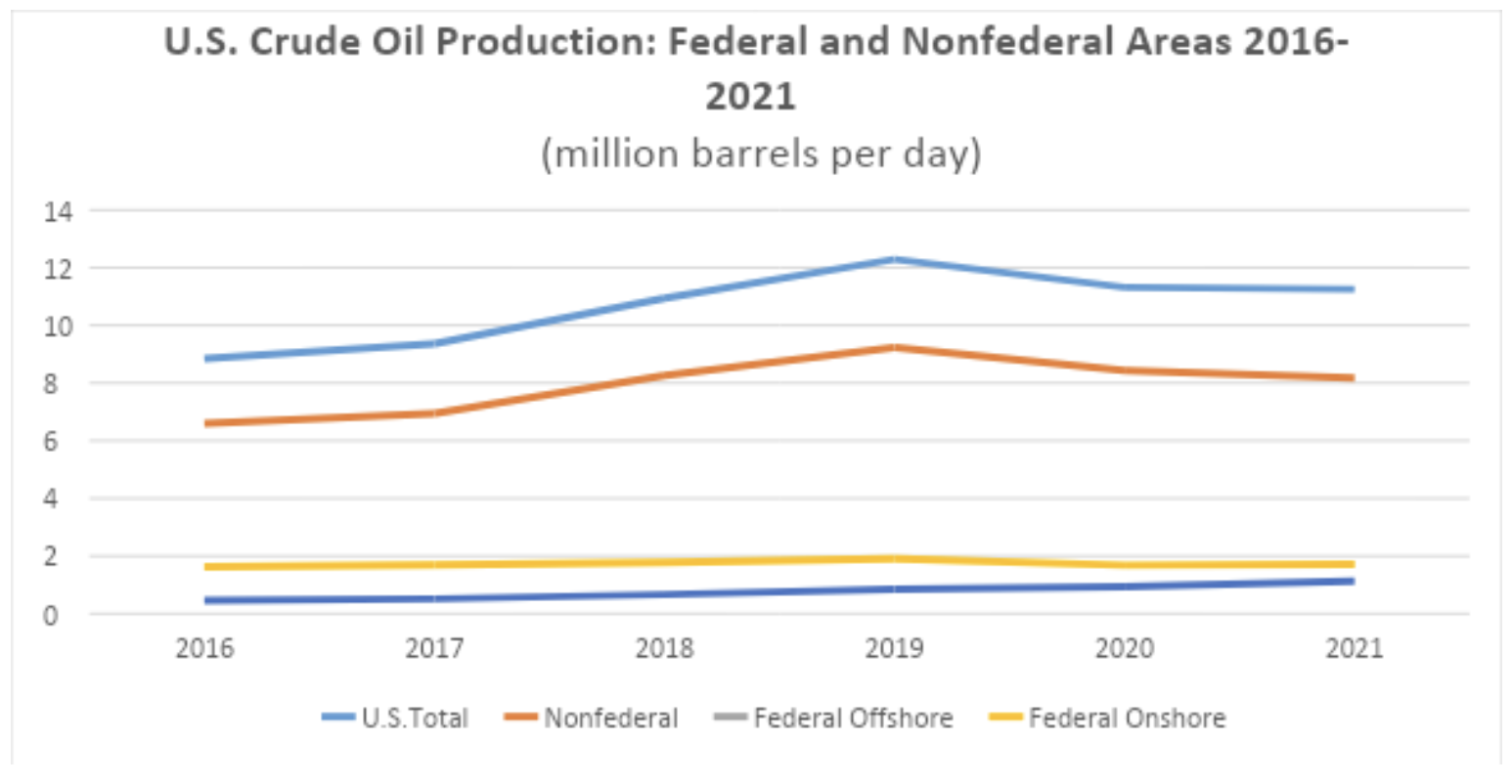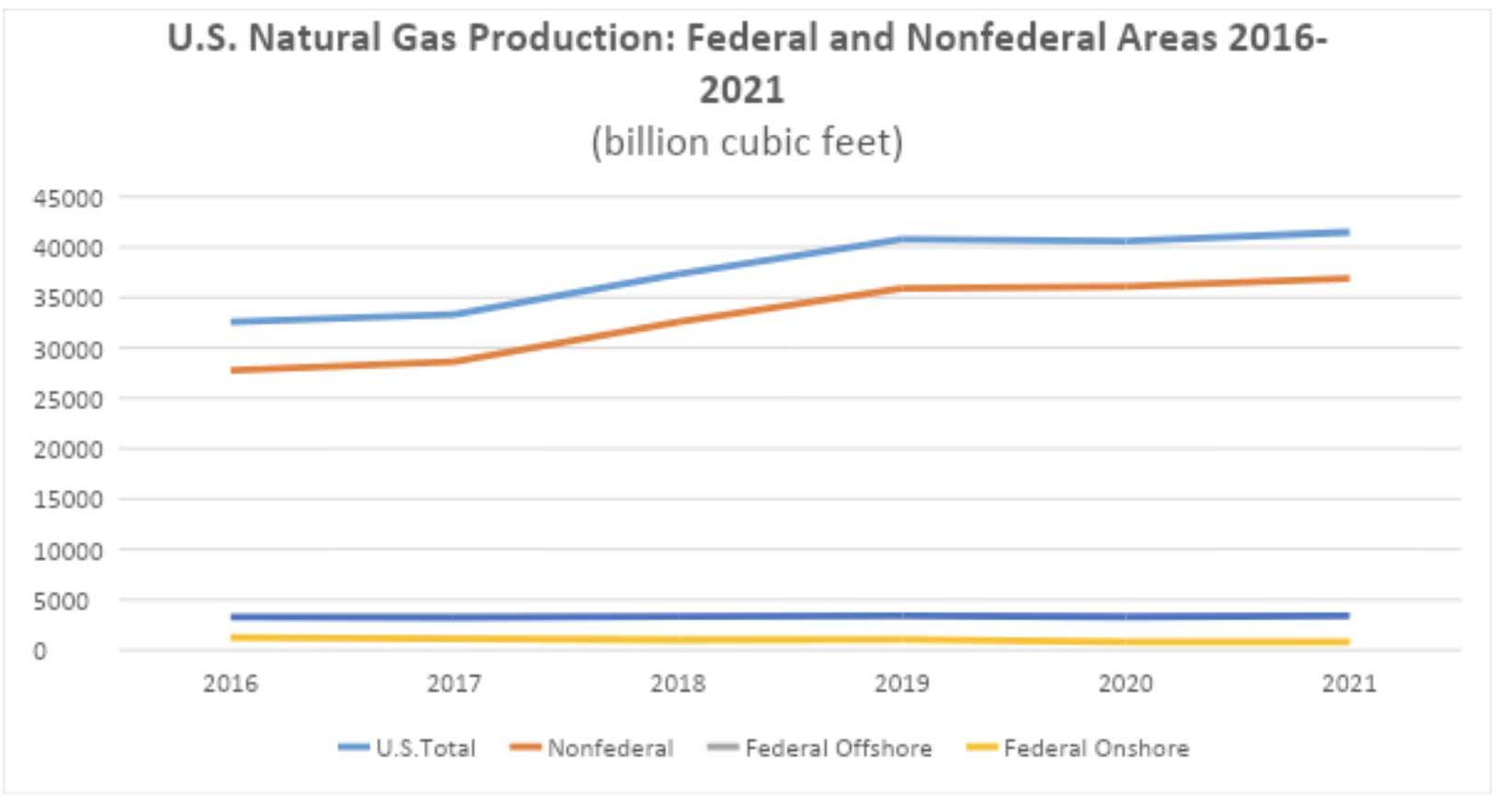Whether it is oil production or natural gas production, output on nonfederal lands (state and private) has consistently been significantly higher than output on federal lands, despite the federal government owning much more mineral estate. One would think the opposite to be true because royalty rates on federal lands are typically less than royalty rates on state or private lands. The issue is that the federal government has implemented an immense amount of red tape so that in order to obtain the rights to drill and operate on federal lands, it takes a staggering amount of time and delay. For example, in fiscal year 2021, it took on average of 182 days to complete an application for a Permit to Drill on Federal lands. In comparison, in Texas, in 2018 and 2019, it took an average of two days to process standard drilling permits. The 180-day difference in the permitting time is the reason that Texas has higher royalty rates than the federal government—a 2-day processing time is worth much more to a company than a 182-day processing time, and certainty is important especially when energy prices are volatile and raging inflation adds to costs of labor and materials. Federal laws and bureaucracy make it far more difficult and expensive to operate on federal lands.
The relative acreages of mineral estate available to the federal government versus state and private lands are instructive in this regard. The federal mineral estate contains 2.46 billion acres, made up of 1.76 billion acres in the Outer Continental Shelf and 700 million of onshore lands. The state and private land mineral estate is around 1.5 billion acres by comparison. The federal mineral estate is over 62 percent of the nation’s total, yet the vast majority of the nation’s oil and natural gas comes from private and state lands.
Oil Production
Historically, crude oil production on federal lands (onshore and offshore) was consistently under 20 percent of total U.S. production until the late 1990s. Then, production percentages increased on federal lands (primarily offshore) to over 30 percent in the early 2000s and reached a high point in 2009, coincident with declining production on non-federal lands in Alaska and other states. Most recent data from the Department of Interior and the Energy Information Administration show crude oil production in the federal offshore to be 15 percent of total U.S. oil production and 10 percent on federal onshore lands in 2021. Crude oil production on federal lands, particularly offshore, could continue to make a significant contribution to the U.S energy supply picture if laws and regulations would allow oil companies to make a profit from its production.
However, Biden’s climate/tax bill (the so-called Inflation Reduction Act) does the opposite. It increases federal royalties and fees and even imposes new fees on the oil and gas industry in both the private and public sectors. The additional fees add millions of dollars in operating costs to producing oil and natural gas in the United States, pricing out even more oil and gas production on federal lands, and putting oil prices in the control of OPEC+. The Biden Administration is intentionally increasing energy costs for American families and making it harder for oil and gas companies to produce and explore on lands owned by the American public, apparently in hopes of forcing people to use electric vehicles and force other changes on their lives.
U.S. Crude Oil Production: Federal and Nonfederal Areas 2016-2021
(million barrels per day)

Natural Gas Production
Natural gas production in the United States has basically steadily increased since 2008, while production on federal lands has declined each year from 2009 to 2017, increasing in 2018 and 2019, and dropping again in 2020 and 2021. Much of the decline was due to a decrease in offshore production. Federal natural gas production fluctuated around 30 percent of total U.S. production for much of the 1980s through the early 2000s, after which there began a steady decline (as a percent of U.S. total production) through 2021. Most recent data from the Department of Interior and the Energy Information Administration show natural gas production on the federal offshore to be 2 percent of total U.S. natural gas production and 8 percent on federal onshore lands in 2020.
U.S. Natural Gas Production: Federal and Nonfederal Areas 2016-2021
(billion cubic feet)

As noted from the table below, there has been significant growth in nonfederal production. The picture of natural gas production is different than that of federal crude oil in that federal natural gas had accounted for a much larger portion of total U.S. natural gas production over the previous few decades.
The shale gas renaissance is the reason for the growth in natural gas production from nonfederal lands because shale plays are primarily situated on nonfederal lands where most of the growth in production has occurred in recent years.
Oil and Gas Provisions in the Inflation Reduction Act
Sec. 50261 of the Inflation Reduction Act increases the royalty rate for offshore oil and gas production from 12.5 percent to between 16.67 percent and 18.5 percent—a 33 percent to 50 percent increase. For onshore oil and natural gas development on federal lands, the added costs are much more extensive. Sec. 50262 updates the Mineral Leasing Act to:
- Increase the royalty rate from 12.5 percent to 16.67 percent – a 33 percent increase, but less than the royalty rate for the June 2022 lease sales, which was set at 18.5 percent.
- Increase the minimum bid amount five-fold for acreage from $2 per acre to $10 per acre. This provision also increases the time period for payments from two years to 10 years.
- Double the rental rate from $1.50 per acre to $3 per acre, which will last for two years after the lease begins and then increase to $5 per acre for six years and at least $15 per acre for each year after that.
- Add an “expression of interest fee” of $5 per acre nominated, which will be increased at a minimum of every four years.
- Increase the bonding requirement from $10,000-$25,000 per well to a minimum of $150,000 per lease. If an operator would like to bond all leases in a state, the amount would be $500,000 and for all of their leases nationwide it would be $2,000,000.
In addition to these increased costs, Sec. 52063 of the bill expands the royalties paid for both onshore and offshore production to encompass all methane produced, consumed or lost, rather than just what is produced and sold.
While the above deals with production on federal lands only, a provision in the bill impacts all U.S. oil and natural gas production and the transportation and exportation of natural gas – regardless of whether it takes place on private or federal property. Previously referred to as a “methane fee” in earlier versions of the act (i.e. the Build Back Better bill), Sec. 60113 imposes a “waste emissions charge” for facilities reporting more than 25,000 metric tons of carbon dioxide equivalent greenhouse gas emissions annually. Using EPA’s assessment, it is equivalent to about 1,000 metric tons of methane. The tax is assessed on the production and gathering of oil and natural gas, and on the transmission, storage and exporting of natural gas using an initial cost factor of $900 per ton for 2024 emissions, $1,200 per ton for 2025 and $1,500 per ton for 2026 and each year after.
According to one estimate, “This tax could increase U.S. consumer natural gas bills by 17 percent on average or more than $100 per year for an average American family. By the American Gas Association’s estimates, “the tax will increase natural gas bills at a minimum of 12 percent per American family per year.” The increase could be the difference between buying groceries and paying to heat one’s home during the winter. The above estimates were made for this past winter and prior to inflation hitting record levels in 2022. These new costs come at a time when 20 million U.S. households – 1 in 6 – are behind in paying their utility bills.
Conclusion
President Biden has taken a series of destructive measures to hurt the oil and gas industry in the United States by killing pipelines, shutting down oil and gas leasing (before a court order mandated Biden to allow them to resume), and increasing fees on oil and gas drilling to name just a few. These actions result in energy being harder to produce and more challenging to discover. Therefore, gasoline and home heating prices are higher than they have been in quite some time and will get even higher due to Biden’s climate/tax bill. But Biden refuses to make the connection between his disastrous policies and the rise of energy prices. Instead, he has asked the Federal Trade Commission to investigate whether or not energy companies are gouging their prices to squeeze more money out of consumers, asked OPEC to produce more energy to moderate prices, and is selling emergency oil supplies from the Strategic Petroleum Reserve through October to keep gasoline prices in check before the mid-term election.
Under the Trump administration, the United States became energy independent—a goal that U.S. governments wanted to reach for decades. The United States had become the world’s leading oil and natural gas producer, thanks to the American energy renaissance, and Americans were reaping its benefits from low gasoline prices, inexpensive natural gas for home heating, and nearly flat electricity prices. But the Biden administration’s anti-oil and gas policies are making those realities go away as it transitions the U.S. economy to a net zero carbon-based economy. The policies of the Biden Administration and the Democrat-controlled Congress have increased energy prices and will continue to do so as more and more of these negative policies are implemented, particularly those contained in the recently passed Inflation Reduction Act.





